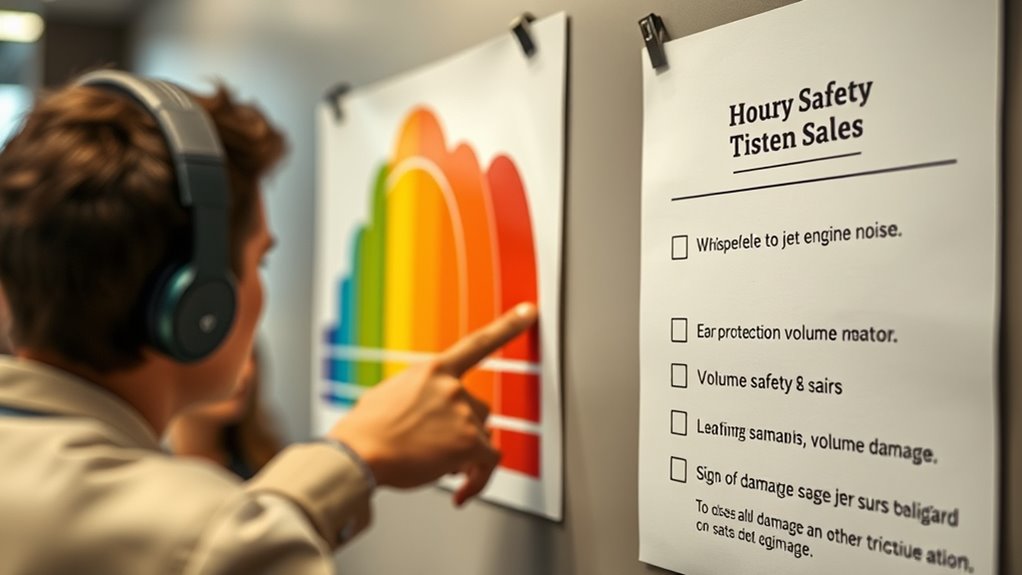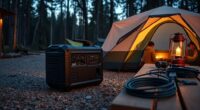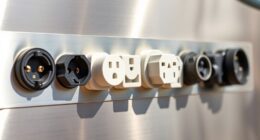Understanding decibel scales is essential for hearing safety, as they measure sound loudness and help you identify harmful noise levels. Normal conversation occurs around 60 dB, while prolonged exposure above 85 dB can cause damage. Protect your ears by using proper hearing protection, taking breaks, and monitoring noise levels. Recognizing signs of hearing damage early is important. Keep exploring to learn simple steps for staying safe and protecting your hearing effectively.
Key Takeaways
- Understand how decibel scales measure sound intensity and relate to perceived loudness.
- Identify safe noise exposure levels (generally below 70 dB) and recognize hazardous environments.
- Use the Noise Reduction Rating (NRR) to select appropriate earplugs for different noise levels.
- Follow hearing safety practices, including proper earplug use, limiting exposure time, and monitoring decibel levels.
- Regularly assess noise environments and maintain hearing protection to prevent irreversible hearing damage.
What Are Decibels and Why Do They Matter?

Decibels are units that measure the intensity of sound, helping us understand how loud a noise is. But they also relate to sound frequency, which determines whether a sound is high or low-pitched. Decibel calibration guarantees measurements are accurate across different devices, so you can trust the readings. When you hear a sound, its loudness depends on both its decibel level and its frequency. For example, high-frequency noises like a whistle can seem more piercing, even at lower decibel levels. Understanding decibels helps you gauge potential hearing risk and avoid damage. Proper calibration guarantees your sound measurements are precise, making it easier to protect your hearing. Recognizing what decibels represent is essential for staying aware of safe listening levels in everyday situations. Additionally, awareness of sound exposure levels is crucial for preventing long-term hearing loss.
Common Sound Levels and Their Decibel Ratings

Understanding the typical sound levels you encounter daily can help you gauge when noise might pose a risk to your hearing. For example, normal conversation happens around 60 decibels, while busy traffic reaches about 85 decibels. Music concerts often hit 100 to 120 decibels, which can cause hearing damage if you’re exposed for long periods. Industrial noise can be even louder, sometimes exceeding 130 decibels, such as in factories or construction sites. These high decibel levels can damage your hearing over time. Knowing these common sound levels helps you recognize when noise is potentially harmful. If you find yourself near loud sounds like concerts or industrial environments, it’s essential to take precautions like wearing hearing protection. Staying aware of sound levels is key to safeguarding your hearing health.
Understanding Safe Hearing Limits

Knowing your safe hearing limits is essential to prevent damage from loud noises. Your hearing threshold is the minimum sound level you can detect, which varies with sound frequency. Generally, sounds below 70 decibels are safe for most people over long periods. To understand your safe limits, consider:
Knowing your safe hearing limits helps prevent damage from loud noises and long-term exposure.
- Recognizing that exposure to sounds above 85 decibels can cause hearing loss over time.
- Knowing that high sound frequency noises, like sirens, may seem louder even at lower decibel levels.
- Monitoring how long you’re exposed; even moderate sounds can be harmful if sustained too long.
- Being aware of protective styling options, such as crochet styles for locs, which can help reduce exposure to potentially harmful noise levels by minimizing the need for frequent styling or hair adjustments.
How to Protect Your Hearing in Noisy Environments

When you’re in a loud environment, protecting your hearing is essential. Wearing hearing protection devices like earplugs or earmuffs can make a big difference. Additionally, limiting the time you spend exposed to loud noise helps prevent damage. Using hearing protection devices that are appropriate for the noise level can further safeguard your hearing health.
Use Hearing Protection Devices
In noisy environments, wearing hearing protection devices is essential to prevent permanent damage to your ears. Proper ear protection helps reduce noise levels and safeguards your hearing health. To effectively shield your ears, consider these tips:
- Choose the right ear protection—ear protection like earplugs or earmuffs that offer high noise reduction ratings (NRR).
- ensure a snug fit—properly fitted devices maximize noise reduction and comfort.
- Use both if needed—combine ear protection for extremely loud environments for added safety.
- Remember that Hearing Safety is crucial for maintaining your overall well-being and quality of life.
Limit Exposure Duration
Ever wonder how long you can safely stay in a loud environment without risking hearing damage? Staying within sound exposure limits is essential to prevent noise-induced hearing loss. The longer you’re exposed to high decibel levels, the greater your risk. To protect your hearing, limit your time in noisy settings—generally, at 85 decibels, you shouldn’t exceed about 8 hours. For every 3 dB increase, cut that time roughly in half. If noise levels hit 100 dB, keep your exposure under 15 minutes. Remember, consistent exposure beyond these limits can cause irreversible damage. Monitoring your time in noisy environments helps you stay within safe sound exposure limits and keeps your hearing healthy. Always be mindful of noise levels and duration to avoid unnecessary hearing loss. Energetic alignment can also influence how well you protect your hearing and overall well-being in noisy environments.
Recognizing Signs of Hearing Damage

Have you noticed ringing, buzzing, or muffled sounds after exposure to loud noises? These are common tinnitus symptoms and early warning signs of hearing damage. Recognizing these signs quickly can help prevent further harm. Floating on Water activities, such as attending noisy water parks or participating in aquatic exercises near loud environments, can also contribute to hearing stress if proper precautions aren’t taken.
Noticing ringing or muffled sounds after loud noise? Early signs of hearing damage—pay attention and protect your ears.
- Persistent ringing or buzzing in your ears even after noise exposure
- Difficulty understanding speech, especially in noisy environments
- Sensitivity to loud sounds or sudden discomfort when sounds are loud
If you experience any of these, don’t ignore them. Tinnitus symptoms often signal that your hearing is being affected. Early warning signs, like muffled hearing or increased sensitivity, indicate that your ears need a break. Addressing these signals early can save your hearing health long term.
Practical Tips for Hearing Safety Every Day

To protect your hearing daily, keep track of how long you’re exposed to loud sounds and take breaks when needed. Wearing appropriate hearing protection, like earplugs or earmuffs, can considerably reduce risk during noisy activities. These simple steps make a big difference in maintaining your hearing health over time. Being aware of decibel scales helps you understand safe noise levels and avoid potential hearing damage.
Limit Exposure Duration
Managing how long you’re exposed to loud sounds is essential for protecting your hearing. Prolonged exposure increases the risk of noise-induced hearing loss, so controlling your sound exposure management is key. Here are three practical tips:
- Keep track of your exposure time, especially in noisy environments, and take regular breaks.
- Limit your listening sessions to 60 minutes or less at high volumes.
- Use apps or devices that monitor decibel levels and alert you when you’re at risk.
- Regularly check your sound levels to ensure they stay within safe ranges.
Use Hearing Protection
Using hearing protection is one of the most effective ways to prevent damage from loud sounds in everyday situations. Selecting the right earplugs is essential; their effectiveness depends on earplug effectiveness and noise reduction ratings. Higher ratings mean better sound attenuation, so choose accordingly. Keep earplugs clean and properly inserted for maximum protection. Reusable earplugs offer durability, but disposables are convenient for occasional use. Proper maintenance and understanding of decibel scales can help you better assess noise levels and choose suitable hearing protection.
Frequently Asked Questions
How Are Decibel Levels Measured Accurately?
You measure decibel levels accurately by using proper measurement instruments like sound level meters, guaranteeing they are calibrated regularly. Calibration techniques involve comparing the instrument’s readings with a known reference sound, which helps correct any discrepancies. Always follow manufacturer instructions for calibration, and use the device in consistent conditions to get precise measurements. This ensures your decibel readings truly reflect the actual sound levels, keeping safety and compliance in check.
Can Hearing Damage Occur Instantly or Gradually?
Hearing damage can occur both instantly and gradually. If you’re exposed to sounds above the hearing damage threshold, damage can happen immediately, especially with loud noises like gunfire or fireworks. However, repeated exposure to high decibel levels over time can cause gradual damage, weakening your hearing without immediate pain. To protect yourself, avoid prolonged exposure to loud sounds and stay within recommended decibel limits.
Are There Different Decibel Scales for Various Environments?
Did you know that decibel scales vary based on environment? You’re likely familiar with the A-weighted scale, which uses frequency weighting to mimic human hearing sensitivities in quieter settings. Different environments, like industrial sites or music venues, might use specific scales to measure sound intensity accurately. These tailored scales help guarantee safety by reflecting how your ears perceive sounds in various contexts, effectively protecting your hearing health.
How Long Can I Be Exposed to Loud Noises Safely?
You can typically be exposed to loud noises for about 15 minutes without risking hearing damage if the noise level is around 100 decibels. To protect your ears, guarantee your earplug fit is snug, as poor fit can increase risk. Limit noise duration and take breaks, especially in very loud environments, to prevent hearing loss. Always use proper hearing protection when exposed to high decibel levels.
Do Hearing Protection Devices Work Equally Well for Everyone?
Hearing protection devices work differently for everyone because of variations in noise reduction and hearing sensitivity. Your ear shape and the fit of the device influence how well it reduces noise. Some people may experience better noise reduction with certain earplugs or earmuffs, while others might need different styles. To guarantee maximum protection, choose the right device for your hearing sensitivity and always fit it properly.
Conclusion
Think of your ears as delicate lanterns, shining brightly but vulnerable to the storm of loud sounds. By understanding decibels and following safety tips, you’re shielding these lanterns from flickering out too soon. Protecting your hearing isn’t just about avoiding noise—it’s about keeping your inner light steady and bright for years to come. So, stay mindful, and let your ears glow with health, illuminating your world with clarity and joy.





